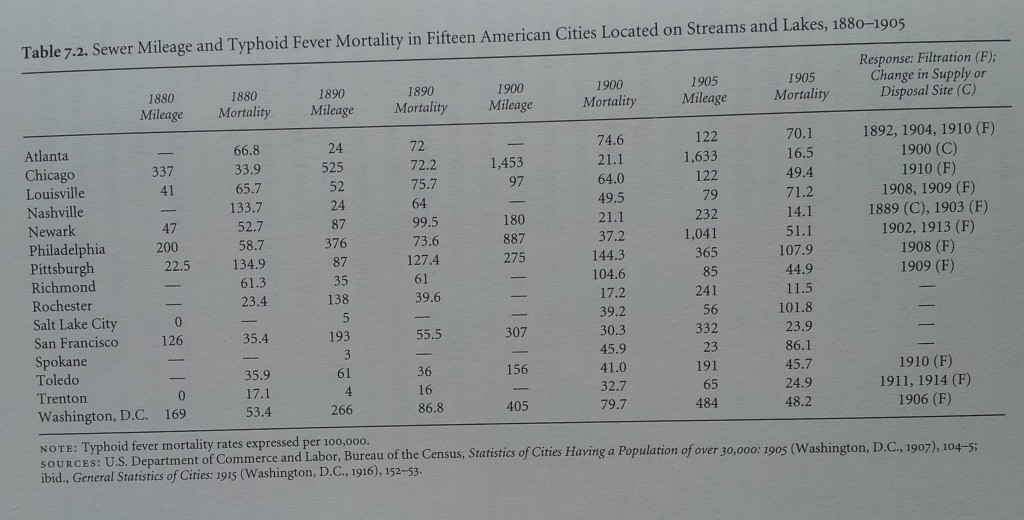A Rough History of Sanitation in the West

Oxygen is bubbled into to tanks of sewage to encourage soil bacteria to devour the nutrients in sewage. Keeping soil bacteria alive in water is energy intensive.
Piped water service began in the early 19th century before sewers were used for anything other than stormwater drainage. Convenient water that didn’t have to be hauled from a shared pump led to a 10-fold increase in water consumption that overwhelmed infiltration and open drainage systems. Worse, wealthier urbanites installed flush toilets. This new, unanticipated technology started overflowing the cess pits that otherwise contained undilute excrement that could accumulate for years without having to be emptied (facts and figures below). Sanitary sewers were built to mitigate overflowing sewage and eliminate the health risk related to the threat of disease from miasmatic sewer gas. These sewers failed to stop the spread of typhoid, increased its infection rates downstream of sewer outlets, and the miasmatic gasses they were designed to mitigate turned out to not exist.
Legal changes during the 18th and 19th centuries encouraged the industrialization of rivers as UK and US common law shifted from a “prior use” to a “beneficial use” doctrine of natural resource allocation, leading inadvertently to heavy industrial pollution by the early 19th century. Pollution was seen as inevitable and recovering a clean drinkable river an impossibility, so in the late 19th century cities invested in drinking water treatment instead of sewage treatment and an end to river dumping of industrial waste. The decision was made to let rivers become open sewers. Treated drinking water, not toilets and sewers, stopped epidemic enteric disease. Mortality rates juxtaposed with sewer construction mileage demonstrate this point most clearly in the well documented cases of Paris, Atlanta, Pittsburgh, Trenton, and Toledo, and sketch a similar picture in other cities.
Clean, treated drinking water took the wind out of the sails of nascent environmental initiatives of the late 19th and early 20th centuries, and untreated sewage discharge steadily increased until the 1950’s and 1960’s when legislation such as the Clean Water Act and its many local precursers lead to the construction of wastewater treatment plants. Since the 1970’s the US, Canada, Western Europe, and Japan have been doing an excellent job of keeping diseases out of waterways, are doing better than any other industrialized areas at pollution control, and are even doing better than most non-industrialized areas too.
Despite the quality of our sanitation systems, our path to them was not direct, not based in good science, and did not lead to the benefits so often ascribed to toilets and sewers. As the rest of the world works on sanitation, copying our history is probably a bad idea.
Arguments for and against flush toilets and sewers are the same now that they were when construction really got going in the 19th century. Presented below are the 6 major reasons for and against water-carriage of waste debated in the 19th century, presented almost verbatim from Tarr. Bullets are our contemporary evaluations of these issues given current knowledge.
For water carriage of waste:
1. Capital and maintenance costs of building sewerage systems would represent a savings for municipalities over the annual costs of collection under the cesspool-privy vault scavenger system.
- Tarr believes this was probably true, although numbers are hard to come by for the costs of comparable collection systems.
2. Sewerage systems would create improved sanitary conditions and result in lowered morbidity and mortality from disease;
- Despite what British doctors believe, this never happened. Sewers caused mass typhoid epidemics in their own cities and downstream, see the Tarr and Sutcliffe citations.
[2a] such savings could often be translated into financial terms, further stressing the economic benefits to be obtained by adoption of water-carriage technology.
- This is true– modern sanitation is a great public health value, returning more than $7 in savings for every dollar invested.
3. Because of improved sanitary conditions, cities that constructed sewerage systems would grow at a faster rate than those without by attracting population and industry
- This worked, they grew rapidly see Against [3a] below.
Against water carriage of waste:
1. Water-carriage removal would waste the valuable resources present in human excreta that might otherwise be used for fertilizer.
- Mined guano fertilizers and later synthetic fertilizers kept fertilizer prices low and replaced soil nutrients. Only in East Asia was the fertilizer market strong enough to pay for human waste collection, in Europe it was a bust. Alternatives to water-carriage, such as short-lived Dutch vacuum sewers, intended to pay for themselves through fertilizer sales but were almost never profitable and the economics still don’t work in industrial economies.
- The end of cheap, extractable phosphorus within the century is being seriously debated.
2. Water-carriage technology would create public health hazards, such as contamination of the subsoil by leakage, pollution of waterways with threats to drinking-water supplies and shellfish, and the generation of disease-bearing sewer gas.
- Sewer gas (rotten stuff) is know known to be mainly ammonia and hydrogen sulfide, which, although poisonous in large willquantities, were never more than a nuisance. Miasma theory that bad smells lead to disease has been rejected.
- Water carriage did create huge public health hazards for drinking water and shellfish. Even today, roughly 10% of American sewage and 20%-25 of UK sewage (their systems are older) still leaks into groundwater from pipes. 850+ billion gallons are deliberately dumped into rivers, almost entirely by Combined stormwater/wastewater sewers such s those in Portland and New York City. Nutrients and other concentrated pollutants still have significant negative impacts on waterways. In low-density areas, onsite (i.e. septic) systems have similar rates of failure and usually have a higher per-capita groundwater impact.
3. The costs of sewerage systems would create a heavy tax burden.
- The average single family household spends $60 on sewer fees per month or $720/year in Portland, Oregon (City of Portland 2012). In Portland the average family spends 1.3% of their income on sanitation in the form of sewer fees (City of Portland 2012). Sewer fees in Portland were the #2 complaint to the Mayor’s office in 2010 (Mercury 2010).
- Falmouth a town of 31,500 people in Cape Cod is expected to spend 595 million to design and construct a sewer system, costing $18,000 per resident plus $500 in maintenance per year (Barnhart, 2011).
[3a] If financed with bonds, sewers would impose costs on future generations with no voice in the decision.
- Decades of population growth spread out the large up-front bonds of most existing systems.
- World population is expected to peak and decline within the 25-100 year timespans of normal infrastructure bonds, although local conditions vary.
- Many people in suburban and peri-urban areas are often compelled to hooked up to the existing sewer after, rather than before, rapid population growth. The cost of hooking up to the sewers comes to roughly $15,000-$20,000 per resident, not counting usage rates and maintenance. Average Operations and maintenance costs for sewers in portland is $99.6 million moving sewage and $13.9 million treating sewage (City of Portland 2011). Political battles usually ensue (Har 2003).
Sewers won over goverments. While capital and resource intensive, they encourage density and growth. Although polluting, they provide centralized, controllable outcomes that fit 19th century drives for centralization, professionalization, bureaucratization, and control (Tarr).
Sewers and piped water won over users because flush toilets provided a better user experience than wells and pail closets (seat with a bucket under it), were an aspirational household appliance, fit into contemporary notions of progress, and owning one’s own infrastructure comes with surprise costs, rather than easy, steady municipal taxes.
Pail closet (seat with a bucket under it) were used by a majority of residents of Manchester, Copenhagen, and other poorer European cities into the 1930s. These systems were effective but labor-intensive, and failures happened above ground, so that smells, spills, and failures were closer to people, rather than hidden underground. Decentralized collection technologies, including vacuum pumps, and water-tight vessels were in their infancy and less developed and reliable than plumbing (See De Decker). America’s last pail collection system ended in 1998 in Skaneateles.
The contemporary alternatives, and what we might do:
Historically, capital itensive and centralized sanitation won out over labor intensive and decentralized systems. In the future, can we know design systems that are less capital intensive, more information intensive and that aren’t labor intensive? Toilets have a long way to go, and there is probably no magic bullet, and lots of work on service models are needed. Below are a few contemporary case studies:
Storing and Pumping:
Japan’s pump-out systems serve 10% of the population (Hidenori)
GTZ Technology Review of Urine Diversion Components
GTZ Urine Reuse Urine as Liquid Fertilizer in Agricultural Production in the Philippines: A Practical Field Guide
Composting in Place:
Bullitt Building in Seattle:
Urine Diverting Dry toilets SSWM Fact Sheet: http://www.sswm.info/category/implementation-tools/water-use/hardware/toilet-systems/uddt
Ecodistrict MBRs +vacuum systems OHSU
everything you could ever want to know about it: DEQ site evaluations of the OHSU system
Containerized collection case studies– SOIL in Haiti, Acra (EAWAG review)
Joe Jenkins talks toilet response in Haiti: video
Accra, Ghana’s Co-composting system.
Approach towards Sanitation Education: CLTS ,
Latrines: the VIP (Ventilated Improved Pit Latrine)

The size of the average person’s excrement and the amount of water required to flush it using a low flow dual flush toilet. Luke provided for scale.
Amount of Poop and pee a person actually generates in a year:
lower limit of feces: feces: 843 g/week= 0.843 liters (if it weighs the same as water) = 51 cu inches * 52=2,652 cubic inches = 1.5 cubic feet or 11.5 gallons
–>based on 843g/week, Digestive Diseases and Sciences, Vol. 43, No. 11: 1998, 2358.
upper limit of feces 0.6 lbs per day = 272.155 g =0.272 L= 17 cubic inches/day or 0.01 cubic feet or 3.6 cubic feet or 27 gallons
–> based on 0.3-0.6 lbs/day. Gotaas, Composting-Sanitary Reclamation of Organic Wastes. World Health Organization, Monograph No. 31. Geneva: 1953.
Urine: based on 2 pints/day. Gotaas, Composting-Sanitary Reclamation of Organic Wastes. World Health Organization, Monograph No. 31. Geneva: 1953.
flush water:
Water used to flush a toilet: based on .9 gal/flush 5 flush/day Caroma dual-flush toilet, Caromausa.com: 2010
Water/year: 5 visits per day * 1 gallon flush= 5gals/day *365= 1,825 gallons (for an ultra low flow toilet
Victorian Flush toilets were 5-12 gallons a flush– or 9,000-22,000 gallons of water a year.
grey water: is typically over half of the wastewater produced by a household. US, the per capita water use is ten times the world average, averaging 262 litres per day (FOERCH 2007).
CITATIONS:
Tarr, Joel A. The Search for the Ultimate Sink, University of Akron Press, Akron: 1996. summary of arguments for and against water carriage: page 186, sewer mileage vs. typhoid fever mortality: page 189, 190. Water sources, not sewers stopped typhoid: Sutcliffe, Anthony, “The Autumn of Central Paris: the Defeat of Town Planning 1850-1970” McGill-Queens University Press: Montreal: 1971.
Mortality in and Typhoid in Paris, see pages 103-104, 106. A stringent program of quarantine, not sewers, controlled typhoid.
Benidickson, Jamie. The Culture of Flushing, a Social and Legal History of Sewage, University of British Columbia Press, Vancouver: 2007
Changing legal views towards water resources to encourage industrialization, chapter 1, page 11.
FOERCH, W. (2007): Water Conservation. In: Encyclopaedia of Environment and Society, 1919-1922. http://knowledge.sagepub.com/view/environment/n1173.xml
Toilets are the most life-saving technology: A statement agregiously misused by the otherwise wonderful Rose George and repeated ad infinitum by fact-lazy NGOs.
http://www.youtube.com/watch?v=T4zG4xT8svE
Discussed in Boseley, Sarah. “Sanitation rated the greatest medical advance in 150 years” Guardian UK, 18 January, 2007.
http://www.guardian.co.uk/society/2007/jan/19/health.medicineandhealth3
Sanitation returns more than $7 of value for every $1 invested. One of Rose George’s better citations
George, Rose. The Big Necessity Metropolitan Books, London: 2008.
also http://www.youtube.com/watch?v=T4zG4xT8svE
De Decker, Kris. “Recycling animal and human dung is the key to sustainable farming” Low Tech Magazine, Sept 15, 2010.
http://www.lowtechmagazine.com/2010/09/recycling-animal-and-human-dung-is-the-key-to-sustainable-farming.html
for the economics of fertilizer and Dutch vacuum sewers.
King, F.H. “Farmers for Forty Centuries” 1911. for the economics of East Asian excreta reuse.
“Exfiltration in Sewer Systems,” EPA/600/R-01/034: December 2000. http://nepis.epa.gov/Adobe/PDF/2000E6PB.pdf
20-25% of English sewage leaks to groundwater , 8% in Hong Kong, 10% average in the US. Page 18.
Septic seems to have a larger groundwater impact. than sewers, page 25
“EPA Onsite Wastewater Treatment Systems Manual,” EPA/625/R-00/008: February 2002.
http://water.epa.gov/aboutow/owm/upload/2004_07_07_septics_septic_2002_osdm_all.pdf
10-25% of onsite systems are failing– however, failure is usually defined as surfacing sewage, a greater percentage of onsite systems may be contaminating groundwater. Section 1-4, page 8.
“Fact sheet, Report to Congress: Impacts and Control of CSOs and SSOs” EPA, Thursday, August 26, 2004.”
http://cfpub.epa.gov/npdes/cso/cpolicy_report2004.cfm
Fact sheet: http://www.epa.gov/npdes/pubs/csosso_rtc_factsheet.pdf
Sutcliffe, Anthony, “The Autumn of Central Paris: the Defeat of Town Planning 1850-1970” McGill-Queens University Press: Montreal: 1971.
Mortality in and Typhoid in Paris, see pages 103-104, 106. A stringent program of quarantine, not sewers, controlled typhoid.
Benidickson, Jamie. The Culture of Flushing, a Social and Legal History of Sewage, University of British Columbia Press, Vancouver: 2007
Changing legal views towards water resources to encourage industrialization, chapter 1, page 11.
FOERCH, W. (2007): Water Conservation. In: Encyclopaedia of Environment and Society, 1919-1922. http://knowledge.sagepub.com/view/environment/n1173.xml
Toilets are the most life-saving technology: A statement agregiously misused by the otherwise wonderful Rose George and repeated ad infinitum by fact-lazy NGOs.
http://www.youtube.com/watch?v=T4zG4xT8svE
Discussed in Boseley, Sarah. “Sanitation rated the greatest medical advance in 150 years” Guardian UK, 18 January, 2007.
http://www.guardian.co.uk/society/2007/jan/19/health.medicineandhealth3
Sanitation returns more than $7 of value for every $1 invested. One of Rose George’s better citations
George, Rose. The Big Necessity Metropolitan Books, London: 2008.
also http://www.youtube.com/watch?v=T4zG4xT8svE
De Decker, Kris. “Recycling animal and human dung is the key to sustainable farming” Low Tech Magazine, Sept 15, 2010.
http://www.lowtechmagazine.com/2010/09/recycling-animal-and-human-dung-is-the-key-to-sustainable-farming.html
for the economics of fertilizer and Dutch vacuum sewers.
King, F.H. “Farmers for Forty Centuries” 1911. for the economics of East Asian excreta reuse.
“Exfiltration in Sewer Systems,” EPA/600/R-01/034: December 2000. http://nepis.epa.gov/Adobe/PDF/2000E6PB.pdf
20-25% of English sewage leaks to groundwater , 8% in Hong Kong, 10% average in the US. Page 18.
Septic seems to have a larger groundwater impact. than sewers, page 25
“EPA Onsite Wastewater Treatment Systems Manual,” EPA/625/R-00/008: February 2002.
http://water.epa.gov/aboutow/owm/upload/2004_07_07_septics_septic_2002_osdm_all.pdf
10-25% of onsite systems are failing– however, failure is usually defined as surfacing sewage, a greater percentage of onsite systems may be contaminating groundwater. Section 1-4, page 8.
“Fact sheet, Report to Congress: Impacts and Control of CSOs and SSOs” EPA, Thursday, August 26, 2004.”
http://cfpub.epa.gov/npdes/cso/cpolicy_report2004.cfm
Fact sheet: http://www.epa.gov/npdes/pubs/csosso_rtc_factsheet.pdf

